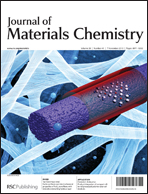The positive effects on the inkjet drop ejection process, thin film morphology and subsequent thin film transistor performance caused by the blending a low molar mass semi-crystalline organic semiconductor, 6,13-triisopropylsilylethynylpentacene (TIPS-pentacene), with a low ε dielectric polymer, polystyrene (350 kDa) are reported. The presence of the high molecular weight polymer at a reduced concentration c/c* = 0.44 gives greater control of the drop generation process (when compared to low molar mass semi-crystalline organic semiconductor alone) due to stabilisation of the ligament break-up process with pinch off occuring at the nozzle plate and satellites coalescing within the main droplet. The addition of a small fraction of a high boiling point solvent results in the removal of droplet drying artefacts by generating a Marangoni flow in which double convection counteracts coffee stain formation. This results in more uniform solute coverage over the substrate, simplifying the print process. Whilst TIPS-pentacene and amorphous polystyrene do not undergo gross phase separation irrespective of deposition process the degree of crystallinity and extent of TIPS-pentacene stratification to the active interface was found to be strongly process dependant. Whilst a lower degree of crystallinity is observed when a dual solvent mixture is used there is strong evidence of greater stratification of the TIPS-pentacene at the active interface resulting in higher saturated hole mobility.

You have access to this article
 Please wait while we load your content...
Something went wrong. Try again?
Please wait while we load your content...
Something went wrong. Try again?


 Please wait while we load your content...
Please wait while we load your content...